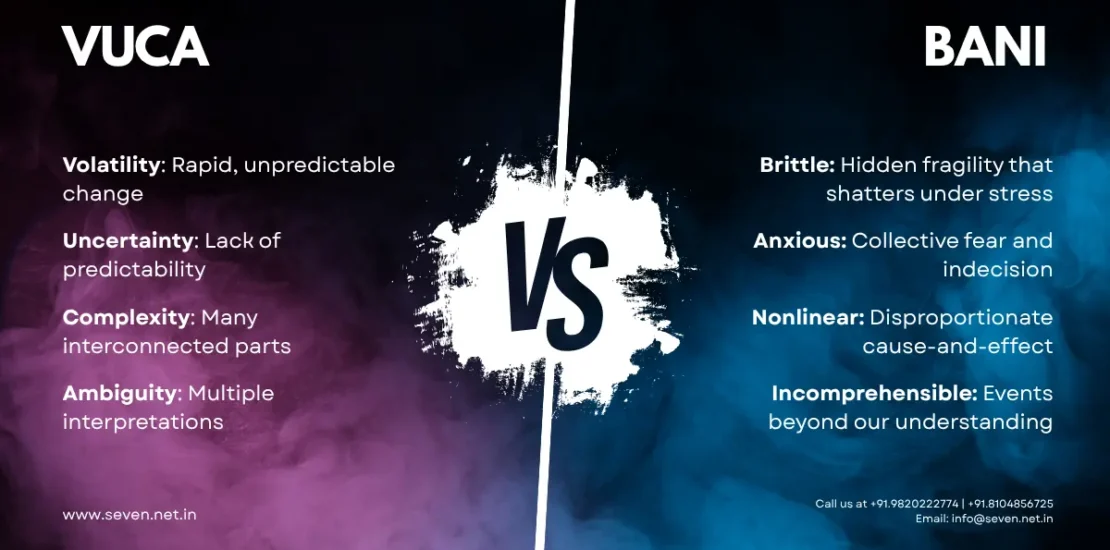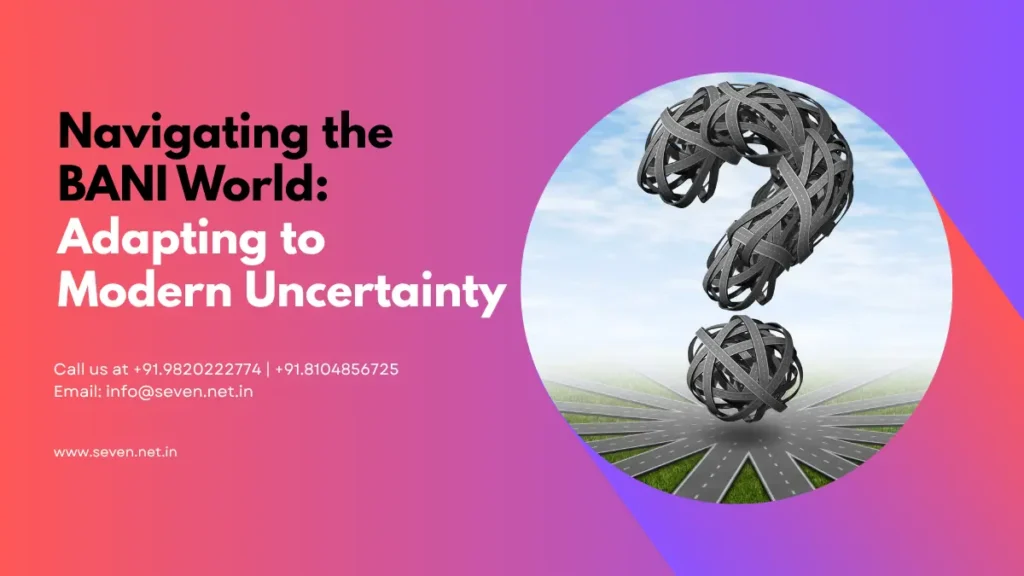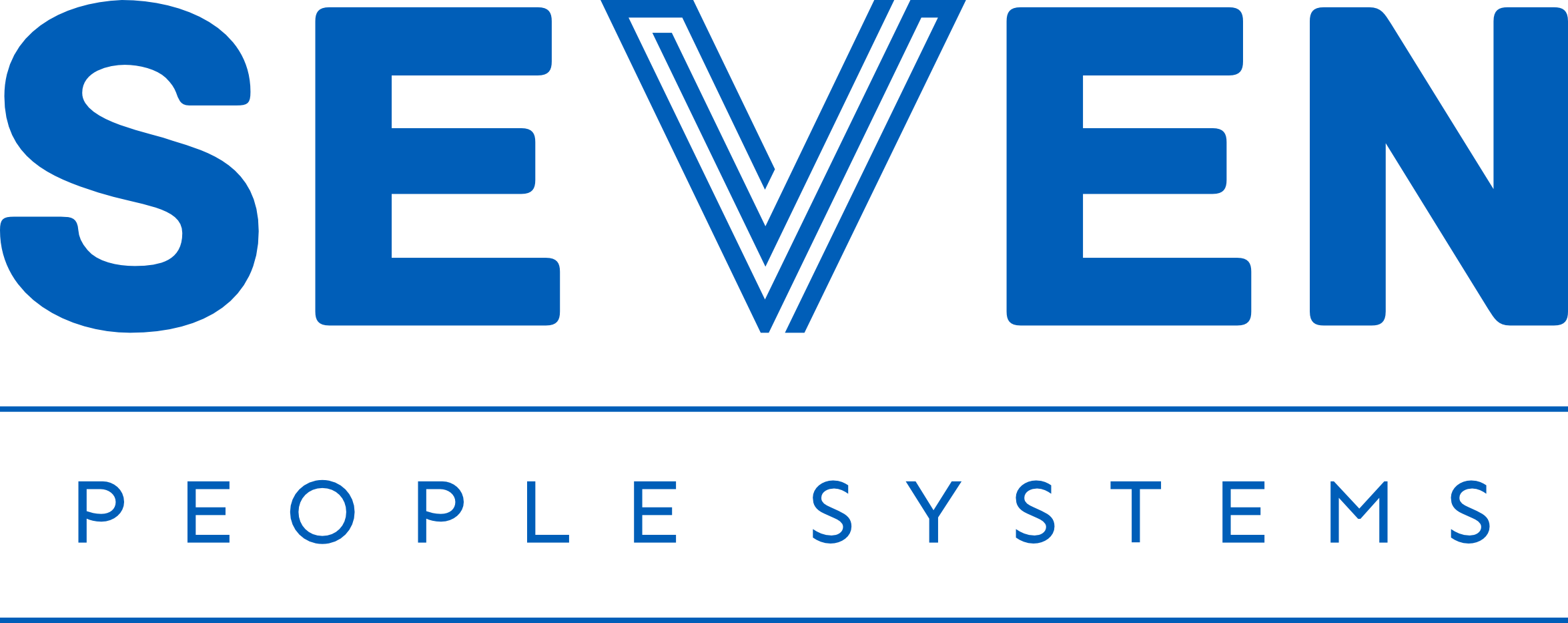VUCA vs BANI
- June 25, 2025
- Posted by: info@seven.net.in
- Category: Uncategorized

Understanding the Future of Uncertainty and Complexity in Leadership
A Snapshot in Crisis: March 2020
It’s a Monday morning in March 2020. A CEO of a mid-sized firm in Dubai, walks into the boardroom prepared for a quarterly strategy review. By Wednesday, the office is empty. The markets have plunged. Her employees are panicking. Her supply chain is broken. And for the first time in her career, the problem isn’t just complexity, it’s fear. It was a classic moment of leadership in uncertainty, where emotional responses overtook strategic plans.
The Illusion of “Normal” Is Gone
Fast forward. It’s 2025. The world hasn’t returned to “normal.” Because “normal,” as it turns out, was a comforting illusion. Climate disasters, mass resignations, AI disruption, viral misinformation, all now part of the everyday vocabulary of leadership in complexity. The rules of the game haven’t changed; the board itself has warped. This reflects a shift from VUCA to a human-centered leadership reality.
Why VUCA No Longer Suffices
For years, leaders were taught to manage in a VUCA world: Volatile, Uncertain, Complex, Ambiguous. But that acronym, born in war rooms, doesn’t quite capture the kind of tightrope we’re walking now.
What do you call a world where systems appear robust but crumble under pressure?
A world where decisions stir more anxiety than assurance?
Where a single unexpected trigger can unleash chaos, and events defy logic or explanation?
Welcome to the BANI world: Brittle, Anxious, Nonlinear, Incomprehensible
This article isn’t just a comparison between VUCA vs BANI, it’s a wake-up call. Because while VUCA explained the battlefield, BANI reveals the battlefield of the mind. And as any leader will tell you, the greatest challenges aren’t always external, they’re what happen inside boardrooms, breakrooms, and between our ears. It’s about navigating psychological safety at work and coping with emotional overload in teams.
Why You Must Pay Attention
If you’re a leader, a strategist, a policymaker, or just a human trying to make sense of this mess, understanding the shift from VUCA to BANI isn’t optional anymore. It’s leadership literacy for the new world.
Let’s begin.
Introduction to VUCA vs BANI Frameworks
Frameworks like VUCA vs BANI help leaders understand and navigate the complex realities of modern life. These acronyms define the forces shaping societies, economies, and organizations today. But while both speak to uncertainty, they do so in profoundly different ways.
VUCA, born in military strategy, highlights the volatile, uncertain, complex, and ambiguous nature of our environment. BANI, a more recent development, dives deeper into emotional and psychological reactions to fragility, anxiety, nonlinearity, and incomprehensibility. Together, they offer complementary lenses for understanding today’s emerging global chaos and crisis.
What Does VUCA Stand For?
VUCA is an acronym representing:
• Volatility: Rapid and unpredictable change.
• Uncertainty: Lack of predictability or unknown outcomes.
• Complexity: Many interconnected parts and variables.
• Ambiguity: Lack of clarity or misinterpretation of facts.
This leadership framework became widely used in strategic planning and military operations after the Cold War. It paints a picture of a world where disruption is constant, and the old ways of managing are no longer enough.
What Does BANI Stand For?
BANI, coined by futurist Jamais Cascio, represents:
• Brittle: Systems look strong but are easily broken.
• Anxious: Heightened emotional instability and fear.
• Nonlinear: Outcomes don’t follow predictable paths.
• Incomprehensible: Events feel too complex to grasp.
Unlike VUCA, BANI focuses on emotional responses to the chaos of today, especially post-2020. It addresses fragility and fear, making it more human-centered and reflective of psychological stress and mental agility needs.

Historical Context and Origin of VUCA
Post-Cold War Military Origins
The VUCA concept originated in the U.S. Army War College to describe the shift in warfare strategy after the Cold War. It explained how the nature of conflict had changed from clear enemies to complex global threats.
Adoption by Business and Leadership Fields
Soon after, the corporate world adopted VUCA to describe the unpredictable nature of global markets, technology disruptions, and geopolitical instability. It became a staple in management theories and leadership programs.
Emergence and Purpose of the BANI Model
Response to Emerging Global Chaos and Crisis
BANI was introduced as a more suitable model for the 2020s. With COVID-19, climate change, AI ethics, and social upheaval, the limitations of VUCA became evident. BANI was developed to explain the new emotional landscape through adaptive systems thinking.
Relevance in a Post-Pandemic World
The pandemic revealed not just uncertainty but human fragility. Healthcare systems collapsed, mental health crises surged, and people felt overwhelmed. BANI helps organizations respond to these deeper, often psychological shifts that require empathetic management.
Key Differences – VUCA vs BANI
Nature of Complexity and Instability
While VUCA focuses on external complexity, BANI highlights the internal, human side of chaos. BANI introduces psychological reactions like anxiety and confusion that were largely absent in the VUCA model.
Leadership Responses Required
VUCA calls for agility, clarity, and vision. BANI requires emotional intelligence, resilience, and empathy. The shift is from strategy to humanity and from analytical models to adaptive thinking.
Emotional and Psychological Implications
VUCA talks about systems and data. BANI addresses burnout, panic, and emotional overload, conditions leaders must now learn to manage in themselves and their teams to foster psychological safety and build resilience in leadership.
Strategies for Thriving in a BANI World
Building Resilience and Empathy
In a BANI world, traditional leadership is not enough. Organizations must:
• Foster resilience at individual and systemic levels. Encourage mental well-being and stress management.
• Lead with empathy, understanding the emotional toll uncertainty takes on employees and stakeholders.
• Provide psychological safety, so people can voice concerns without fear.
Embracing Nonlinearity and Adaptability
Outcomes in a BANI world are rarely linear. To cope:
• Accept unpredictability rather than resist it.
• Adopt flexible planning that accommodates unexpected changes.
• Encourage experimentation, learning from failures without fear.
This approach builds trust, ensures adaptability, and supports decision-making in crisis, even when logic fails.
Real-World Examples of VUCA vs BANI in Action
Business Case Studies
• VUCA Example: Nokia’s Decline
Nokia’s failure to adapt to the smartphone revolution showcases a VUCA environment where technological volatility and complexity overwhelmed outdated strategies.
• BANI Example: Remote Work Transition During COVID-19
Companies shifting to remote work in 2020 dealt not just with logistical changes but emotional anxiety and fragility, a classic BANI scenario involving emotional labor and nonlinear change.
Global Political and Environmental Examples
• VUCA: Brexit
Political unpredictability, economic uncertainty, and complex international relations made Brexit a textbook VUCA event.
• BANI: Climate Change Crises
Natural disasters causing power grid failures, migration, and fear of the unknown reflect a world that is brittle, anxious, nonlinear, and incomprehensible.
Implications for Future Leadership and Organizations
Need for Holistic Thinking and Emotional Intelligence
As the world becomes more interconnected and less predictable, organizations need leaders who:
• Think holistically, seeing the big picture beyond financials.
• Possess emotional intelligence to manage relationships and morale.
• Communicate transparently, especially in times of crisis.
Shaping Future-Ready Leaders
Future leadership development must include:
• Training on systems thinking and adaptive strategies.
• Emphasis on empathy, mindfulness, and mental agility.
• Cross-disciplinary learning to bridge logic with emotion.
The era of one-dimensional leadership is over.
Comparison Table: VUCA vs BANI
| Aspect | VUCA | BANI |
|---|---|---|
| Origin | Military (Post-Cold War) | Jamais Cascio (Post-2020) |
| Focus | Strategic, Systemic | Emotional, Human-Centric |
| Elements | Volatility, Uncertainty, Complexity, Ambiguity | Brittle, Anxious, Nonlinear, Incomprehensible |
| Leadership Needs | Vision, Clarity, Agility | Empathy, Resilience, Psychological Safety |
| Examples | Tech Disruptions, Globalization | Mental Health Crisis, Pandemic Fallout |
| Approach | Analytical, Structured | Emotional, Adaptive |
Conclusion: Preparing for an Uncertain Future
VUCA and BANI aren’t competing models; they’re complementary lenses through which we can view our ever-changing world. While VUCA provides a framework for understanding systemic volatility and ambiguity, BANI brings to light the emotional fragility and unpredictability of today’s reality.
For leaders, success lies in embracing both. By developing strategic vision and emotional resilience, organizations can not only survive uncertainty but thrive in it. The future belongs to those who are prepared to understand complexity, not just intellectually, but emotionally and ethically too.
By applying these tactics, leaders enhance their capacity for navigating complexity, turning the BANI framework’s most mystifying element into an opportunity for insight and innovation.
Interested in a BANI-aligned leadership intervention?
Ready to lead with clarity in a chaotic world? Let Seven People Systems design a BANI-aligned leadership intervention to help your teams build resilience, embrace adaptive strategies, and thrive in uncertainty.
Call Us: +8104856725 | +91.9820222774
Email Us: info@seven.net.in

Frequently Asked Questions (FAQs)
VUCA describes environments that are volatile, uncertain, complex, and ambiguous. BANI takes it further by focusing on emotional fragility, anxiety, nonlinear outcomes, and incomprehensibility.
Not entirely. BANI is seen as an evolution or complement to VUCA. Where VUCA explains systemic challenges, BANI adds a human-centered, emotional layer.
Organizations must prioritize psychological safety, flexible planning, and empathetic leadership. Building emotional resilience across teams is essential.
Leadership in BANI conditions requires high emotional intelligence, adaptability, and the ability to foster trust and calm amidst chaos.
Yes, they complement each other. VUCA is better for strategic planning, while BANI is useful for managing emotional responses and social dynamics.
Healthcare, education, automotive, tech startups, and service industries face high BANI conditions due to constant change, emotional labor, and nonlinearity.
Latest Blogs
- 5 Critical Organisational Problems Adaptability Quotient (AQ) Can Solve
- AI Training & Certification in India: The Complete 2025 Guide to 46 AI CERTs® Programs
- Adaptability Assessment in India: Why AQai is the Benchmark for Leaders and Teams
- How to Choose the Right AI Certification
- Top 10 Adaptability Coaches in India [2025 Edition]

